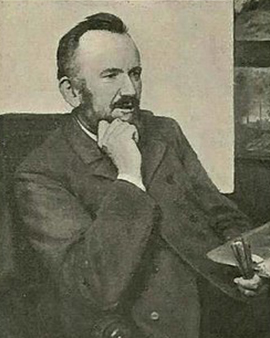Nestled in the peaceful landscapes of Denmark, a future luminary of the art world was welcomed on September 5, 1837 - Janus Andreas Bartholin la Cour. Born in Ringkøbing and raised on the estate of his father, the landowner and politician Otto August la Cour, the young Janus discovered his passion for landscape painting at the tender age of 7 or 8. Soon his teacher Emmerik Høegh Guldberg at the Cathedral School in Aarhus, where Janus studied in his youth, recognized the artistic potential in his first sketches. These crucial beginnings shaped la Cour's destiny as a landscape painter and were to lay the foundation for the future artworks we reproduce today with the greatest care in the form of fine art prints.
A descendant of a French-born family that had emigrated to Denmark in 1732, la Cour could look back not only on a rich family history, but also on an impressive career that found its beginning in private lessons with renowned artists such as Frederik Christian Kiærskou and Wilhelm Marstrand. Despite a relatively late formal artistic education at the Royal Danish Academy of Art in 1857, la Cour had already made his debut two years earlier with his painting "Strandparti ved Helgenæs" at the Charlottenborg Spring Exhibition. Throughout the years of his art career, his deep admiration for the Golden Age of Danish painting was evident in his artwork. His cool, reduced depiction of nature often took place without any figuration, continuing the tradition of his teachers and patrons, such as P.C. Skovgaard and Johan Thomas Lundbye. La Cour's talents were recognized by numerous awards, including the Neuhausenske Premium in 1861 and the Thorvaldsen Medals in 1871. These awards and several scholarships allowed him to travel for study, taking him to France, Italy, and Switzerland, further shaping his artistic influences and techniques. Even though he was fascinated by the art of Jean Baptiste Camille Corot, which he encountered on a trip to Paris in the 1860s, la Cour preferred a clear, unblurred painting technique that was in keeping with Danish tradition.
Despite his admiration for the art of the Golden Age, Janus la Cour was drawn back from the Copenhagen art scene in 1884 and he settled near Aarhus. This deliberate retreat was motivated by his decision to stay away from modern trends such as open-air painting (en plain air) and focus on the academic tradition of the Eckersberg School. Although he remained unmarried throughout his life, he left an impressive legacy of over 870 known works, which were recorded in a biography after his death in 1909. Janus la Cour's works, which can now be seen in all major Danish museums and in the Pomeranian State Museum in Greifswald, Germany, are an impressive display of his talent and dedication to art. As a company that specializes in the reproduction of fine art prints, we are proud to help la Cour's legacy live on through our faithfully detailed reproductions of his works. Each art print we produce is a tribute to an artist who shared his passion for painting with the world and captured its beauty in each and every one of his works.
×





.jpg)
.jpg)
.jpg)
.jpg)
.jpg)
.jpg)
.jpg)
.jpg)
.jpg)
.jpg)
.jpg)
.jpg)
.jpg)
.jpg)
.jpg)
.jpg)
.jpg)
.jpg)
.jpg)
.jpg)
.jpg)
.jpg)
.jpg)
.jpg)
.jpg)
.jpg)
.jpg)
.jpg)
.jpg)
.jpg)
.jpg)
.jpg)
.jpg)
.jpg)
.jpg)
.jpg)
.jpg)
.jpg)
.jpg)
.jpg)
_-_(MeisterDrucke-932688).jpg)
_-_(MeisterDrucke-932688).jpg)




